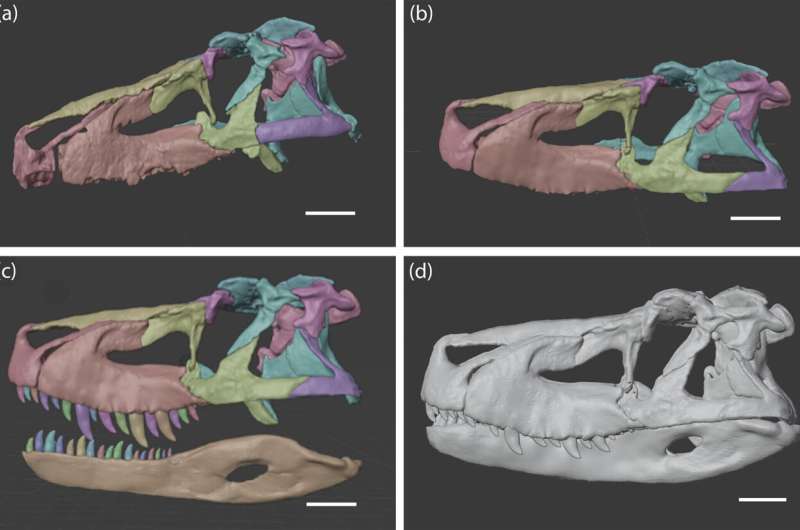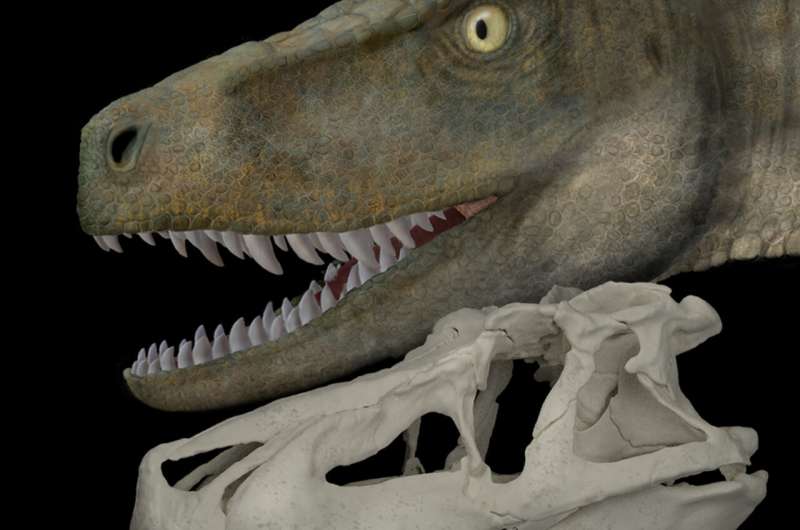This article has been reviewed according to Science X's editorial process and policies. Editors have highlighted the following attributes while ensuring the content's credibility:
fact-checked
trusted source
proofread
Massive pre-Jurassic reptile had weaker bite than modern crocs

The apex predators that roamed the earth 230 million years ago had a much weaker bite than previously thought, and likely couldn't crunch through bone to consume the entirety of their kills.
In a new study published in The Anatomical Record, paleontologists from the University of Birmingham have recreated the original skull anatomy of Saurosuchus, a Late Triassic reptile that is the distant relative of modern crocodiles. Saurosuchus was thought to be an apex predator due to its size and diet, standing at between 5–8 meters in length and weighing over 250 kg.
However, the latest analysis of the skulls of the reptile and comparisons with the later well-known dinosaur Allosaurus found that despite their similar skull strengths, the earlier crocodile relative Saurosuchus had a much weaker bite than the dinosaurs that followed it. Saurosuchus would have had a bite with the force of 1015–1885 N, equivalent to modern crocodiles called gharials.
For comparison:
- Allosaurus: 3,572 N
- Saltwater crocodiles have a bite force of ~16,000 N
- Tyrannosaurus rex: 17,000-35,000 N
Dr. Jordan Bestwick, vertebrate palaeobiologist at the University of Birmingham and corresponding author of the paper said, "We found that Saurosuchus actually had an incredibly weak bite for its size and thus predated animals in very different ways compared to later evolving dinosaurs. In fact, despite being one of the bigger lizards and an apex predator, the Saurosuchus had a bite that was on a par with the relatively measly bite of the gharial, and much less powerful than more fearsome crocs and alligators around today.
"You would still would have liked to leave Saurosuchus well alone, but they likely fed only on the soft fleshy bits of their kills as their bite wouldn't have enabled them to crunch up bones."

Careful eaters
Despite their relative size, Saurosuchus would have been a careful diner that used their back teeth to remove the flesh from their kills, the study suggests.
In contrast to later dinosaurs, the feeding behavior of Saurosuchus is likely due to a weak bite and a more rectangular skull shape. Also these earlier reptiles had thinner bones in their noses compared to the later Allosaurus.
Dr. Stephan Lautenschlager, Associate Professor in Palaeobiology at the University of Birmingham and senior author of the paper said, "The Saurosuchus would certainly have been a fearsome reptile until it sat down to eat its prey, and we can see how evolutionary details in the skulls of these massive apex predators necessitated significant differences in eating behavior. While dinosaurs that followed in the Jurassic period would have eaten the vast majority of their kills, Saurosuchus may have left more complete carcasses, which would have provided a secondary meal for carrion-feeding animals too."
Molly Fawcett, co-author of the paper said, "It is truly amazing how similar the skulls of top predators in the Triassic period (the time before the domination of the dinosaurs) look compared to the well-known carnivorous dinosaurs such as the T. rex. However, unexpectedly we found that the bite power of these Triassic predators were far weaker compared to the post-Triassic dinosaurs."
More information: Molly J. Fawcett et al, Functional morphology of the Triassic apex predator Saurosuchus galilei (Pseudosuchia: Loricata) and convergence with a post-Triassic theropod dinosaur, The Anatomical Record (2023). DOI: 10.1002/ar.25299. anatomypubs.onlinelibrary.wile … doi/10.1002/ar.25299
Provided by University of Birmingham





















